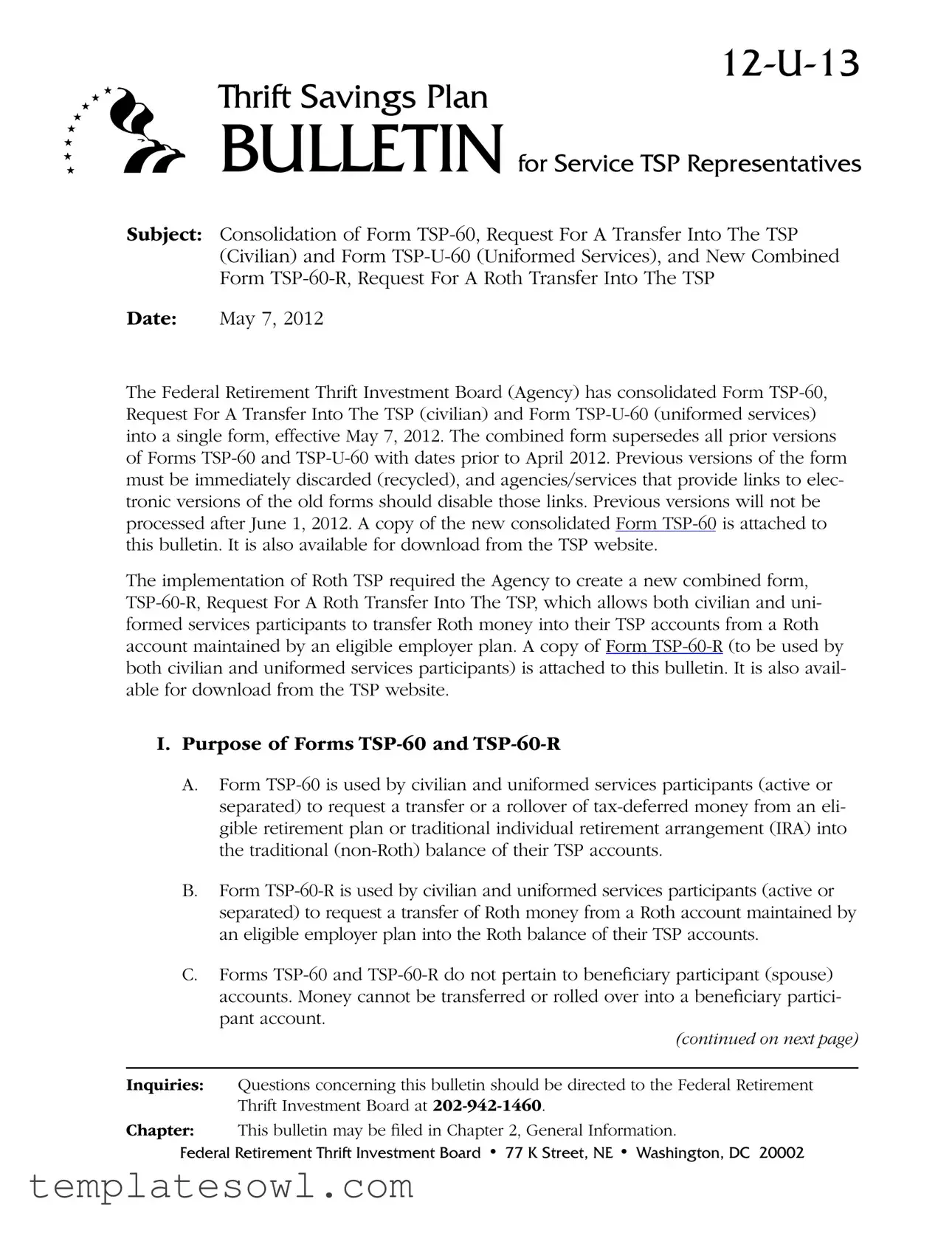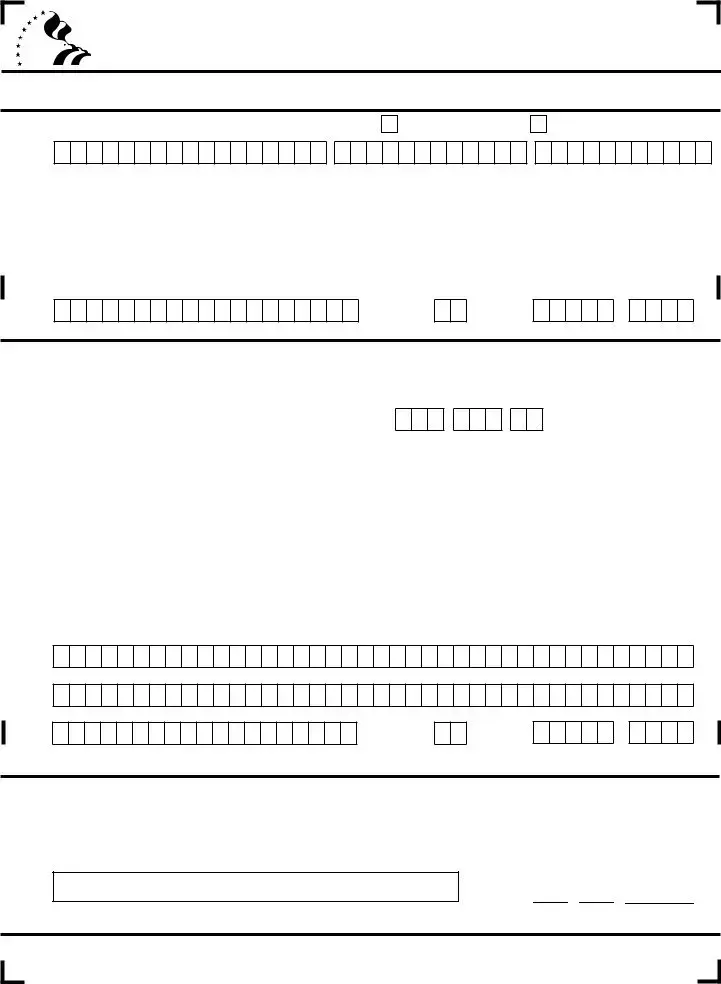Form TSP-60-R should accompany your transfer check to avoid complications. Sending the form and check separately could delay the processing of the transaction. A separate form is required for each check that your plan administrator sends to the TSP.
If the TSP does not receive a Form TSP-60-R, but receives a check without a participant’s identification (name and TSP account num- ber or Social Security number), the original check will be returned to the sender.
If the TSP receives a check with appropriate identification, but without Form TSP-60-R, the original check will be held for up to 15 days (without earnings) pending receipt of the completed form (and supporting documentation, if necessary). After that time, if the form (and any other necessary documentation) is not received, the check will be returned to the sender.
Be sure to read all of the general information and instructions before you complete this form.
What Roth distributions will the TSP accept?
The TSP will only accept transfers of qualified and non-qualified Roth distributions from any applicable retirement plan, as de- fined in Internal Revenue Code (IRC) § 402(e)(1), under which an employee may elect to make Roth contributions. An applicable retirement plan includes a plan qualified under IRC § 401(a) (e.g., a 401(k) plan); an IRC § 403(b) tax-sheltered annuity; or an IRC
§457(b) plan maintained by a governmental employer. It does not include a Roth IRA.
The TSP will not accept rollovers of qualified or non-qualified Roth distributions that have already been paid to you.
To be accepted into the TSP, the distribution must be an “eligible rollover distribution.” An eligible rollover distribution is a distribu- tion to a participant of all or a portion of his or her account. How- ever, it cannot be:
•one of a series of substantially equal periodic payments made over the life expectancy of the employee (or the joint lives of the employee and designated beneficiary, if appli- cable), or for a period of 10 years or more;
•a minimum distribution required by IRC § 401(a)(9);
•a hardship distribution;
•a plan loan that is deemed to be a taxable distribution be- cause of default; or
•a return of excess elective deferrals.
Examples of eligible rollover distributions include: a lump sum distribution after terminating employment; an age-based in-serv- ice withdrawal; a final single payment after a series of monthly payments; monthly payments lasting less than 10 years; death benefit payments; or payments made to a spouse or former spouse pursuant to a qualified domestic relations order (QDRO).
Before submitting this form, a TSP participant who would like to transfer Roth money into the TSP should check with a representa- tive of his or her plan to determine what portion of a distribution (if any) meets the applicable requirements.
Note: Participants are required to certify in Section III of this form that the distribution they are seeking to transfer into the TSP meets the applicable requirements. If a participant cannot sign the certification, the TSP cannot accept the transfer.
What is the difference between a “qualified” and a “non-quali- fied” Roth distribution?
A Roth distribution is considered qualified (i.e., paid tax-free) if a participant has reached age 59½ (or is permanently disabled*) and 5 years have passed since January 1 of the year associated with the participant’s first Roth contribution. If a participant has not met these conditions, the Roth distribution is considered non-qualified (i.e., the Roth earnings are subject to Federal in- come tax when withdrawn) until the participant satisfies these requirements.
What is a “Roth Initiation Date”?
The TSP defines a Roth Initiation Date as the specific date of a participant’s first Roth contribution. The IRS uses January 1 of the year associated with a participant’s first Roth contribution to de- termine whether Roth earnings are qualified.
What happens to a Roth Initiation Date at the time of a transfer?
If a participant has an existing Roth balance in his or her TSP ac- count at the time of the transfer, the Roth Initiation Date will be the earlier of either the start date associated with the incoming Roth balance or the start date associated with the existing TSP Roth balance. This date will be applied to all Roth money already in the participant’s TSP account, as well as any future Roth contri- butions to the TSP.
If a participant does not have an existing Roth balance in his or her TSP account, the transfer will establish one, and the Roth Initiation Date will be the start date associated with the incoming Roth balance.
What tax-deferred distributions will the TSP accept?
The TSP will accept both transfers and rollovers of tax-deferred money from any eligible retirement plan as defined in IRC § 402(c) (8)(B). An eligible retirement plan includes a traditional individual retirement account (IRA), a SIMPLE IRA to which the participant has contributed for at least 2 years, and an eligible employer plan.
•Traditional IRA. This is an individual retirement account described in IRC § 408(a) or an individual retirement annu- ity described in IRC § 408(b). The traditional IRA category does not include a Roth IRA, an inherited IRA, or a Coverdell Education Savings Account (formerly known as an education IRA); distributions from these types of IRAs will not be ac- cepted by the TSP.
•SIMPLE IRA. This is a Savings Incentive Match Plan for Em- ployers, an employer sponsored retirement plan available to small businesses. A TSP participant can transfer an amount from a SIMPLE IRA to the TSP, as long as he or she partici- pated in the SIMPLE IRA for at least 2 years. Note: The TSP must receive written documentation showing the period of participation in a SIMPLE IRA.
•Eligible Employer Plan. This is a plan qualified under IRC § 401(a) (including a § 401(k) plan, profit-sharing plan, de- fined benefit plan, stock bonus plan, and money purchase plan); an IRC § 403(a) annuity plan; an IRC § 403(b) tax- sheltered annuity; or an IRC § 457(b) plan maintained by a governmental employer.
* The TSP cannot certify to the IRS that you meet the Internal Revenue Code’s definition of disability when your taxes are reported. Therefore, you must provide the justification to the IRS when you file your taxes.
Form TSP-60-R (4/2012)
PREVIOUS EDITIONS OBSOLETE




 /
/

 /
/





 /
/

 /
/



